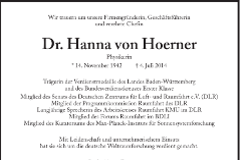Company History
Von Hoerner & Sulger (vH&S) is a small enterprise, acting since 1971 very successfully in the fields of scientific space- and rocket-borne systems, robotic systems for planetary exploration, medical analytical systems, and systems for science and industry in general.
The areas of operation of vH&S cover the broad range of concept finding, feasibility studies, development, fabrication, and qualification of complete systems for scientific applications. The system capabilities make vH&S unique in the industrial landscape, since this expertise is usually expected from significantly larger entities only. “Our customers in particular appreciate our flexibility, our efficiency, as well as the direct contact with the technical and management staff” said Dr. Hanna von Hoerner, the late founder of vH&S. Since its foundation, vH&S developed and produced more than 15 space-qualified scientific instruments and more than 30 rocket experiments. Prominent examples for space instruments are the first cometary spectrometer ever flown, PUMA (1+ 2), which were built back in 1981-1984 for the two Russian missions VEGA 1 and 2 to comet Halley.
The company was founded with the objective to create a small innovative research and development laboratory for scientific and industrial partners, handling also the manufacturing of all space instruments defined in the labs. Located 80 km south of Frankfurt in Schwetzingen, between Heidelberg and Mannheim, vH&S has a staff of almost 30 employees and is today well recognised for highly qualified space instrumentation. The average yearly turnover is approximately 5 million Euro.
Although being a smaller company, the expertise of vH&S is diversified:
The rocket-borne experiments, which vH&S has been developing from the beginning, are analysing various aspects of the ionosphere and upper earth atmosphere, particularly charging effects and minute pressure fluctuations. All these instruments have been built for university institutes and have been flown on sounding rockets from Andøya, Norway, the Esrange in Kiruna, Sweden, and from Biscarosse, France.
Another focus of vH&S is the development and fabrication of various mass spectrometers, which became one of the main activity fields, starting with PUMA 1 and 2. Since then the company built several instruments for detailed analysis of interstellar or cometary dust. And now it established itself in the field of various analytical instruments for science, e.g. laseroptical instruments for chemical or mineralogical analysis.
For the in-situ planetary exploration, the company is active in another area of small but smart developments: Mini- and microrobotics. vH&S is one of the first European addresses for design and development of micro- and minirovers. The most prominent example for that technology is the NANOKHOD Microrover, with a mass of only 3 kg, including 1 kg of payload mass. Furthermore the company has gained a lot of experience in the sensor technology by developing several digital video cameras that provide the know-how of online image-compression technologies.
The company’s highly-skilled team of physicists and engineers transforms the various scientific objectives and requirements into system concepts and specifications, performs hardware and software development, and supervises the high-rel fabrication process throughout all phases until an instrument is integrated within the company’s cleanroom facilities and then finally qualified for flight.
This expertise and teamwork as well as the ability to collaborate with external partners from space agencies like ESA and NASA, research institutes, and universities, are the reasons for the vH&S success story. vH&S is equipped with a well established manufacturing facility to produce industrial hardware: electronic laboratories with state-of-the-art CAD systems for development and analysis, 3D CAD systems for mechanical engineering, as well as modern cleanroom facilities (down to class 1000) for the integration of the complete space systems. Own test laboratories with vacuum chambers are used for the accommodation and functional qualification of space experiments or subsystems.
As of today vH&S has accumulated robust know-how, experience, and space heritage, and established itself as an important member in the European space industry, with their long-term experience in acting as prosperous prime and sub-contractor in most of the major European space projects.


